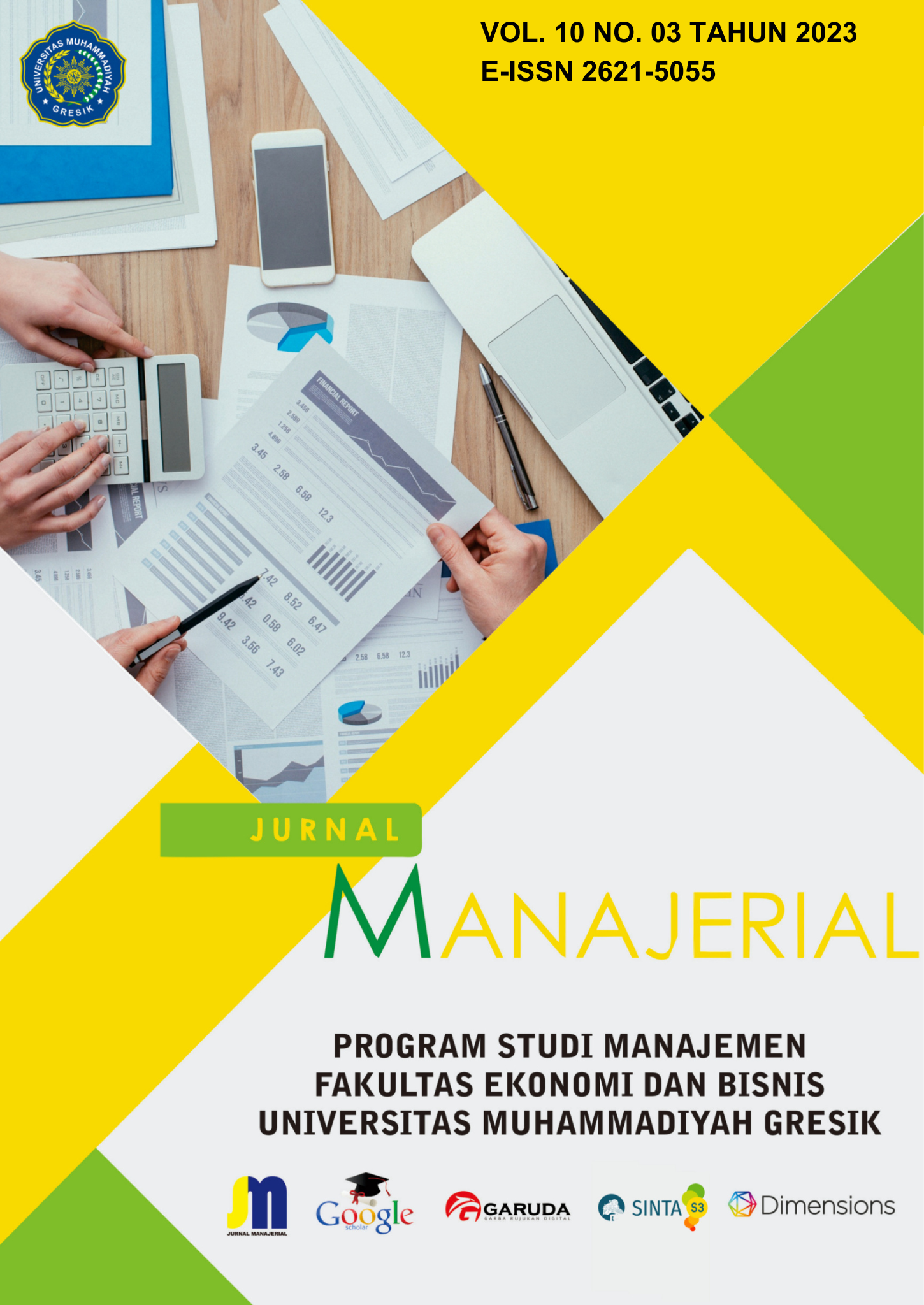Marketing Strategy Of Fast-Food Restaurants In Indonesia - Sosial Network Analysis On Twitter
DOI:
https://doi.org/10.30587/jurnalmanajerial.v10i03.5524Keywords:
Social, Media, Fast, Food, Marketing, StrategyAbstract
Background – Fast food restaurants are a culinary business where competition is quite tight, especially in the Covid-19 era. To face competition between restaurants which is quite close, companies must have many strategies, one of which is related to the promotion strategy.
Aim – This study aims to compare the marketing strategy content between Mcdonald's and Burger King and identify the focus of discussion of Twitter users on fast food restaurants.
Design/ Methodology/ Approach – This research uses a social network analysis (SNA) approach with a qualitative descriptive research type. SNA is a form of social computing that extracts large amounts of data. This research uses secondary data sources from tweets with discussions of McDonal's and Burger King in 2017-2022 with data collection.
Findings – The study results show that the marketing strategy related to promos carried out by Mcdonald's is Free Shipping, while Burger King's is Cashback. While on the menu, Mcdonald's innovates on the ice cream menu, and Burger King innovates on the burger menu. The marketing strategy related to taste at Mcdonald's and Burger King showed that the two restaurants had a delicious and delicious taste of the products produced by the two companies on the tongues of consumers
Conclusion - Burger King's marketing strategy carried out via Twitter social media is superior to McDonlads' marketing strategy.
Research implication –The research results show that Burger King is famous for the promos it provides, namely cashback where the promo can be used again when making subsequent purchases by consumers. Apart from that, the menu at Burger King is also very varied, starting from different colors and shapes of burgers, therefore Burger King can attract other consumers to buy their products. This strategy can be maintained to improve and maintain products at Burger King restaurants. McDonald's is famous for its delicious burgers, so this can increase consumer purchases, this strategy must also be maintained.
Limitations – This study focuses on two company brands, namely Mcdonald's and Burger King, in this analysis using three marketing strategy criteria as keywords for data collection. The first keyword is a promo, the second is a menu, and the third is taste.
References
Aksoy, H. (2017). How do innovation culture, marketing innovation and product innovation affect the market performance of small and medium-sized enterprises (SMEs)? Technology in Society, 51, 133–141. https://doi.org/10.1016/j.techsoc.2017.08.005
Al Hamdhan, R. (2021). Application of Emphatic Marketing Strategy at Burger King Company on Social Media Against Customer Engagement During the Covid-19 Pandemic. Jurnal Riset Ekonomi Manajemen (REKOMEN), 5(1), 73–80. https://doi.org/10.31002/rn.v5i1.3586
Ali, M., & Nova, R. (2022). FINANCIAL INCENTIVE GAIN E-COMMERCE ’ S COSTUMER – A STUDY FOR SEREY TO ENTER INDONESIAN MARKET. 11, 1–6.
Brata, B. H., Husani, S., & Ali, H. (2017). “The Importance of Training Programs in the Improvement of the Performance of Employees In The Petroleum Companies”- Case of Sonatrach Company - The Regional Directorate of BERKAOUI (Ouargla- Algeria). Saudi Journal of Business and Management Studies, 2(4B), 433–445. https://doi.org/10.21276/sjbms
Campbell, M. C., Jeffrey Inman, J., Kirmani, A., & Price, L. L. (2020). In times of trouble: A framework for understanding consumers’ responses to threats. Journal of Consumer Research, 47(3), 311–326. https://doi.org/10.1093/jcr/ucaa036
Chang, H. (Sean), Capuozzo, B., Okumus, B., & Cho, M. (2021). Why cleaning the invisible in restaurants is important during COVID-19: A case study of indoor air quality of an open-kitchen restaurant. International Journal of Hospitality Management, 94(November 2020). https://doi.org/10.1016/j.ijhm.2020.102854
Genchev, E., & Todorova, G. (2017). Sales promotion activities – effective tool of marketing communication mix. Trakia Journal of Science, 15(Suppl.1), 181–185. https://doi.org/10.15547/tjs.2017.s.01.033
Gupta, M. (2019). A Study on Impact of Online Food delivery app on Restaurant Business special reference to zomato and swiggy. International Journal of Research and Analytical Reviews, 6(1), 889–893. http://ijrar.com/
Ham, J. Van Der. (2021). Toward a Better Understanding of “Cybersecurity.” Digital Threats: Research and Practice, 2(3), 2503–2504. https://doi.org/10.1145/3442445
Hidayat, A., Adanti, A. P., Darmawan, A., & Setyaning, A. N. A. (2019). Factors Influencing Indonesian Customer Satisfaction and Customer Loyalty in Local Fast-Food Restaurant. International Journal of Marketing Studies, 11(3), 131. https://doi.org/10.5539/ijms.v11n3p131
Jain, D. E., & Yadav, A. (2017). Marketing and Technology: Role of Technology in Modern Marketing. IOSR Journal of Business and Management, 19(05), 49–53. https://doi.org/10.9790/487x-1905064953
Janssen, H. G., Davies, I. G., Richardson, L. D., & Stevenson, L. (2018). Determinants of takeaway and fast food consumption: A narrative review. Nutrition Research Reviews, 31(1), 16–34. https://doi.org/10.1017/S0954422417000178
Katole, H. J. (2019). Retailers’ Vs Customers’ views on usage of Sales Promotion as Communication tool. International Journal of Marketing Studies, 4(6), 26–35. https://doi.org/10.5539/ijms.v4n6p174
Mandal, P. (2017). Understanding Digital Marketing Strategy. International Journal of Scientific Research and Management, 5(06), 5428–5431. https://doi.org/10.18535/ijsrm/v5i6.11
Mantik, J., Rivaldo, Y., Victor Kamanda, S., & Yusman, E. (2022). The Influence Of Brand Image, Promotion And Trust On Customer Loyalty At Bank BSI Nagoya Batam Branch Rohmad1,. Jurnal Mantik, 6(2), 2385–2392.
Mutiara, S., Hamid, R. S., & Suardi, A. (2020). Pengaruh Kualitas Layanan Persepsi Harga dan Cita Rasa Terhadap Kepuasan Konsumen. Jesya (Jurnal Ekonomi & Ekonomi Syariah), 4(1), 411–427. https://doi.org/10.36778/jesya.v4i1.300
Nuari, P. F. (2020). Penamaan Menu Makanan di Bali. BELAJAR BAHASA: Jurnal Ilmiah Program Studi Pendidikan Bahasa dan Sastra Indonesia, 5(1), 73–90. https://doi.org/10.32528/bb.v5i1.3008
Patrutiu-Baltes, L. (2016). Inbound Marketing - the most important digital marketing strategy. Bulletin of the Transilvania University of Braşov, 9(Inbound Marketing-the most important digital marketing strategy), 61–68.
Putra, G. P., & Candiwan. (2021). Analisis Peringkat Brand Pada Sosial Media Twitter Menggunakan Metode Social Network Analysis (Studi Kasus KFC Indonesia dan McDonald’S Indonesia). e-Proceedings of Management, 8(3). https://openlibrarypublications.telkomuniversity.ac.id/index.php/management/article/view/14927
Rahayu, S. L., Kusrini, & Fatta, H. Al. (2016). Rancang Bangun Augmented Reality Pada Data Menu Restoran. Eksplora Informatika, 6(1), 22–32. https://eksplora.stikom-bali.ac.id/index.php/eksplora/article/view/101/84
Sallam, M. A. (2016). An Investigation of Corporate Image Effect on WOM: The Role of Customer Satisfaction and Trust. International Journal of Business Administration, 7(3). https://doi.org/10.5430/ijba.v7n3p27
Salloum, S. A., Al-Emran, M., Monem, A. A., & Shaalan, K. (2017). A survey of text mining in social media: Facebook and Twitter perspectives. Advances in Science, Technology and Engineering Systems, 2(1), 127–133. https://doi.org/10.25046/aj020115
Shore, J., Baek, J., & Dellarocas, C. (2018). Network structure and patterns of information diversity on twitter. MIS Quarterly: Management Information Systems, 42(3). https://doi.org/10.2139/ssrn.2813342
Suima, I. (2019). Dialogue as a form of communication. Vìsnik Marìupolʹsʹkogo deržavnogo unìversitetu. Serìâ: Fìlologìâ, 12(20), 271–280. https://doi.org/10.34079/2226-3055-2019-12-20-271-280
Sun, G., Cavusoglu, H., & Raghunathan, S. (2018). An Analysis of Membership-Based Free Shipping Programs of Online Marketplaces. ICIS 2017: Transforming Society with Digital Innovation, 0–18.
Yang, D., & Lee, C. W. (2016). In-Store Promotional Mix and the Effects on Female Consumer Buying Decisions in Relation to Cosmetic Products. International Journal of Management, Economics and Social Sciences, 5(2), 35–56.
Zaenal, & Moeliono, N. N. K. (2021). PREFERENSI KONSUMEN PADA PEMILIHAN RESTORAN CEPAT SAJI ( FAST FOOD ) DI KOTA BANDUNG ( Penelitian pada : McDonald ’ s , KFC dan Burger King ) Pendekatan Menggunakan Analitikal Hierarki Proses CONSUMER PREFERENCES IN FAST FOOD RESTAURANT SELECTION ( FAST F. 8(4), 3772–3781.
Zahara, M., Andreansyah, N., & Relawati. (2017). Pengaruh Kualitas Pelayanan dan Kualitas Produk Terhadap Kepuasan Konsumen Pada Restoran Jambo Kupi Pasar Minggu Jakarta. Jurnal Manajemen dan Bisnis (JMB), 2(1), 42–50. https://www.ncbi.nlm.nih.gov/pmc/articles/PMC3624763/pdf/nihms412728.pdf






























 P-ISSN: 2354-8592 __ E-ISSN: 2621-5055
P-ISSN: 2354-8592 __ E-ISSN: 2621-5055 
